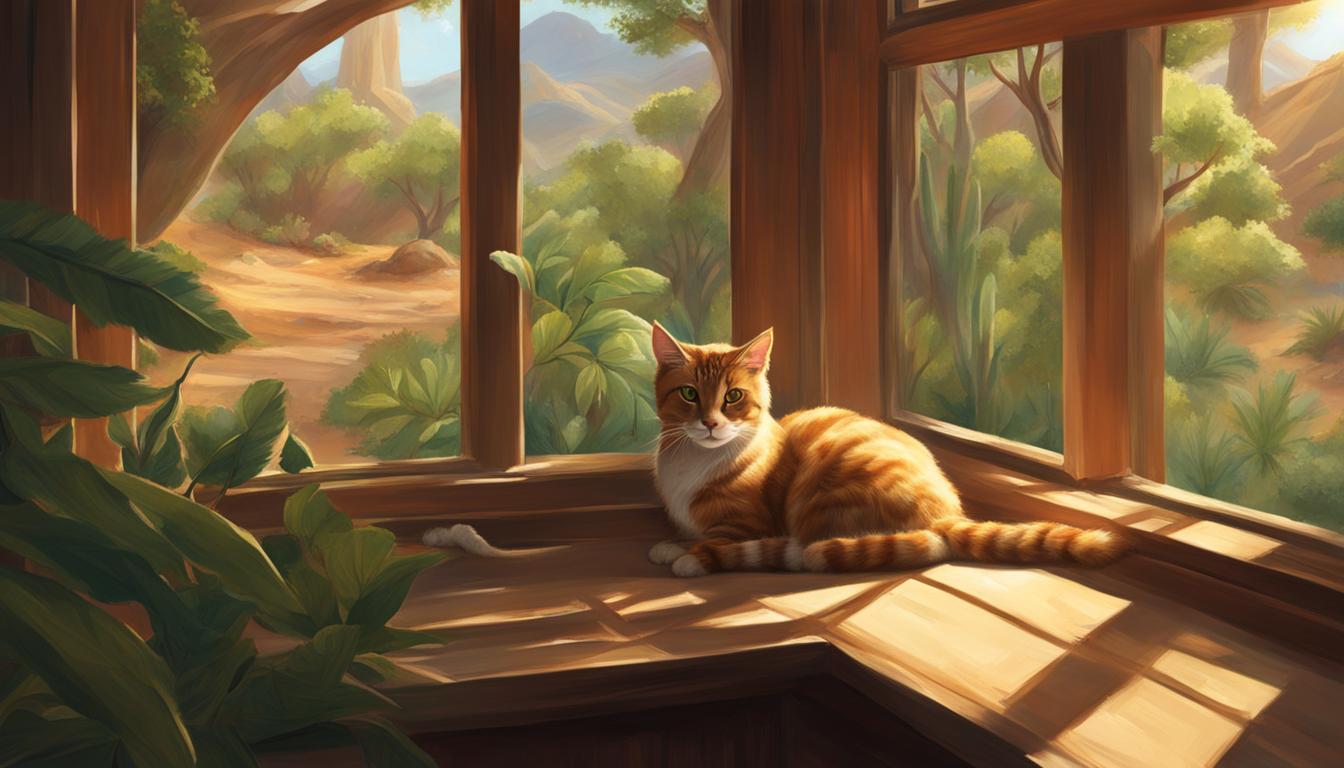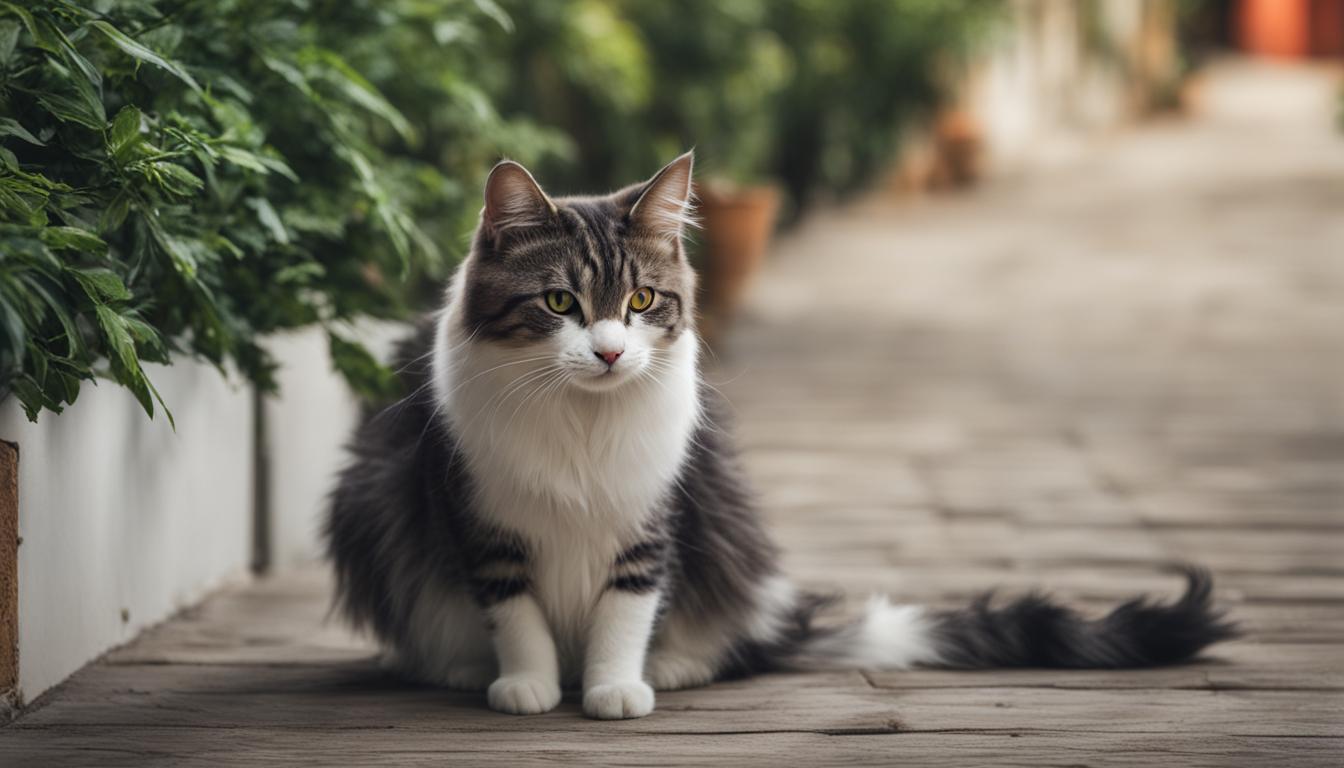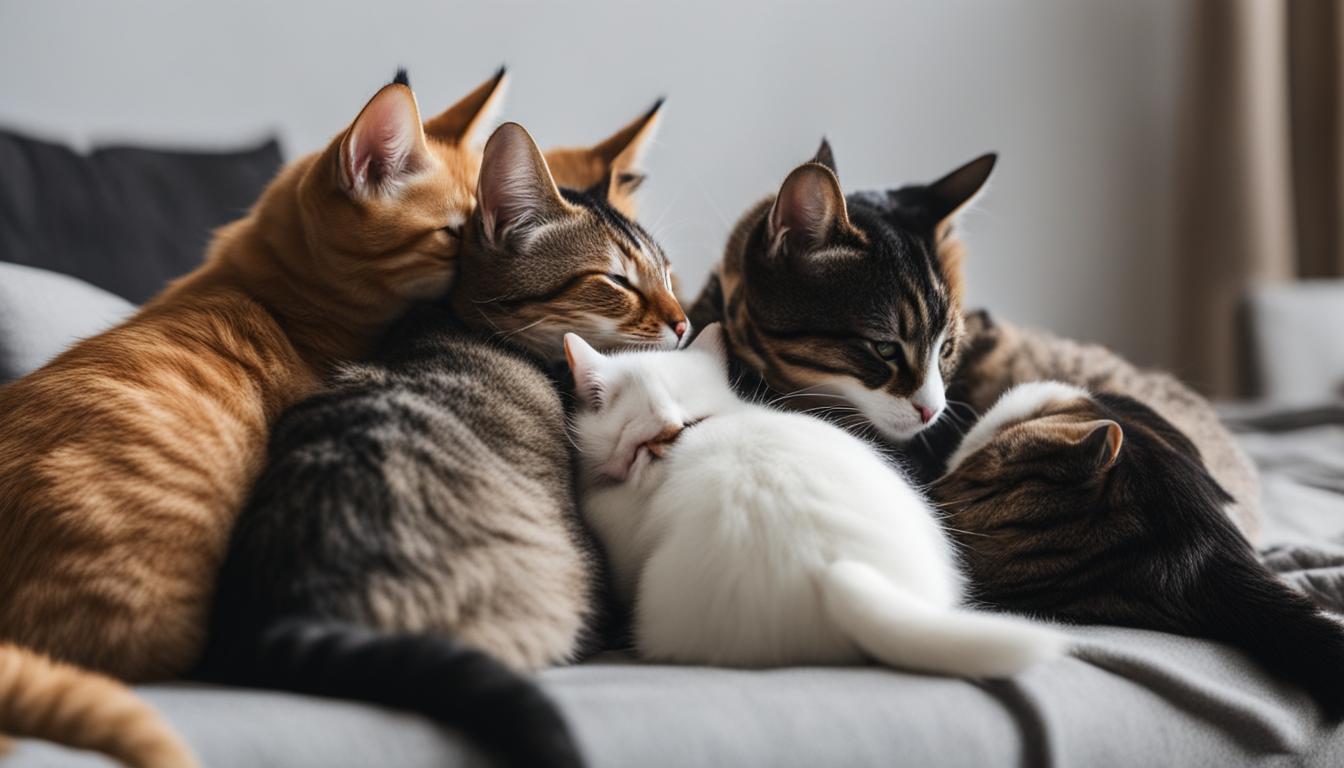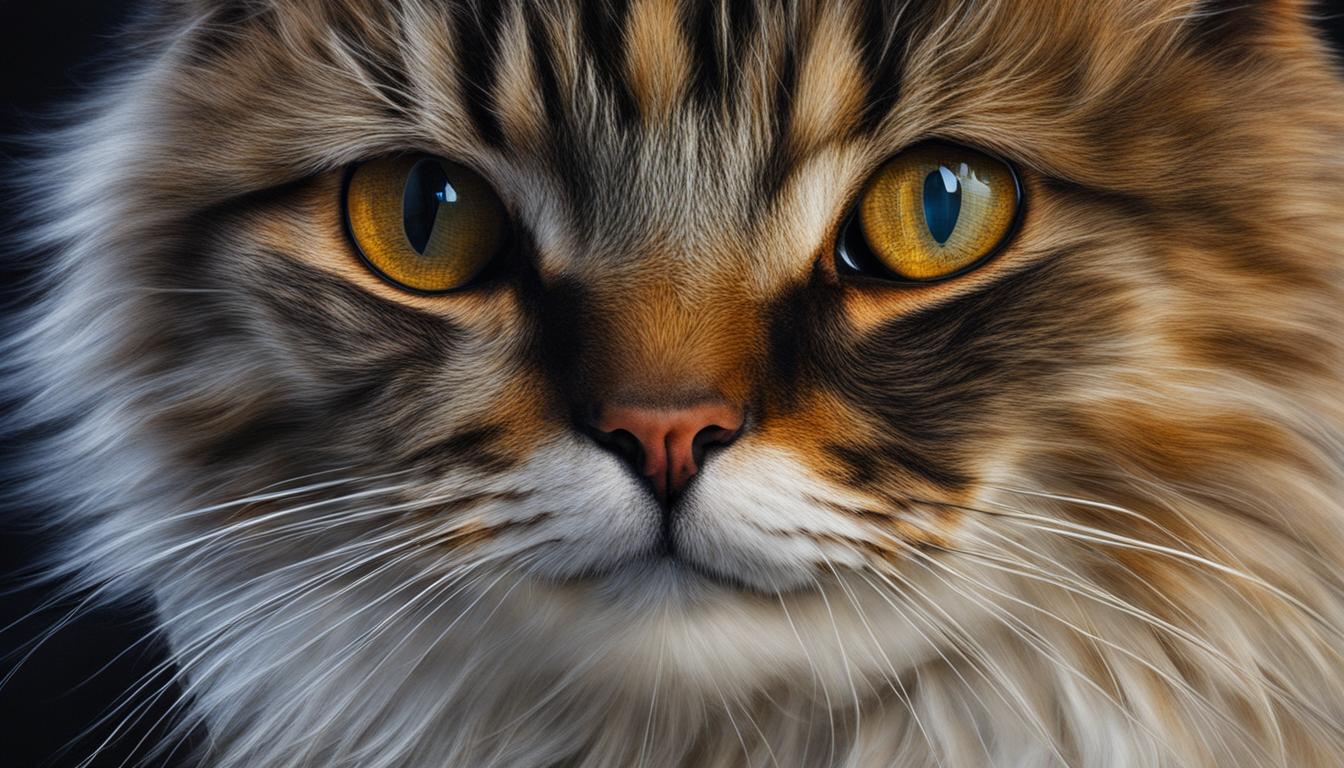Hey there, fellow feline enthusiasts! Today, I want to dive into the fascinating world of cat behavior and how our furry friends adapt to various environments. Cats have been around for millions of years, perfecting their hunting skills and evolving behaviors that help them survive in different settings. Whether they’re strutting through urban jungles or prowling rural landscapes, cats have some pretty cool tricks up their paws.
But before we get into the nitty-gritty details, let’s take a moment to appreciate just how amazing these creatures are. Cats are not your average pet. They’re highly specialized predators, finely tuned to excel in their surroundings. So, let’s embark on this journey together as we unravel the behavioral adaptations of our favorite four-legged companions.
Key Takeaways:
- Cats possess sensory adaptations like incredible night vision, heightened hearing, and a keen sense of smell, aiding them in their hunting endeavors.
- Their natural instincts guide their behaviors, from strategic hunting tactics to playful antics.
- Cats are incredibly adaptable to different environments, but changes may cause stress that requires management.
- Urban and rural settings influence a cat’s behavior, with factors like territory size and unique challenges shaping their actions.
- The environment plays a crucial role in cat welfare, emphasizing the need for enrichment and stress reduction techniques.
Cats’ Sensory Adaptations for Hunting
Cats are well-known for their exceptional hunting abilities, and their success in catching prey can be attributed to their remarkable sensory adaptations. These adaptations enable cats to navigate their environment, detect potential prey, and strike with precision.
Cat Vision
Cat vision is a key sense that aids in their hunting prowess. While cats primarily rely on their sense of smell and hearing, their vision is adapted for hunting in low-light conditions. They possess a layer of cells called the tapetum lucidum, which reflects light back through their retina, enhancing their ability to see in the dark. This adaptation allows them to detect even the slightest movements of their prey, giving them a significant advantage during their hunt.
Cat Hearing
Another vital sensory adaptation in cats is their acute hearing. Cats’ ears are incredibly sensitive to high-frequency sounds, allowing them to detect the faintest rustle of prey. Their ability to swivel their ears independently helps them pinpoint the exact location of a sound, enabling them to plan their approach and strike with precision. It’s no wonder that cats can effortlessly pounce on fast-moving targets with such accuracy!
Cat Smell
Cats possess a highly developed sense of smell, which contributes to their hunting abilities. Their sense of smell is estimated to be 14 times stronger than that of humans. This heightened sense allows them to detect the presence of prey, even if it’s well hidden. Cats rely on their olfactory receptors to analyze scents and determine if there is potential prey nearby. Their sense of smell helps them navigate their environment and identify potential hunting grounds.
Cat Touch
While often overlooked, a cat’s sense of touch also plays a crucial role in hunting. Cats have specialized whiskers called vibrissae on their face and legs, which act as sensitive receptors. These whiskers help cats navigate in the dark by detecting changes in their surroundings, such as the presence of objects or vibrations caused by nearby prey. The whiskers also aid in determining if they can fit through tight spaces, ensuring they can access potential hiding spots or chase down their prey.

In summary, cats’ sensory adaptations, including their exceptional vision, acute hearing, heightened sense of smell, and sensitive touch, are key factors contributing to their success as hunters. These adaptations allow cats to track and capture prey with remarkable precision and efficiency. It’s fascinating to observe how these adaptations have evolved over time, enabling cats to thrive in their natural hunting habitats.
The Role of Instincts in Cat Behavior
Cats are fascinating creatures with a multitude of behaviors that can be attributed to their instincts. These innate instincts are deeply ingrained within their DNA and play a significant role in shaping their behavior. Understanding these instincts can help us better comprehend and cater to the needs of our feline companions.
One of the most prominent instincts in cats is their hunting instinct. Cats are natural-born predators, and even well-fed domesticated cats retain their hunting skills. This instinct drives them to engage in behaviors like stalking, pouncing, and chasing, mimicking the behaviors necessary for catching prey in the wild.
Playfulness is another instinct that is closely tied to a cat’s hunting instincts. Play serves as a vital outlet for a cat’s excess energy and allows them to practice and refine their hunting strategies. Kittens, in particular, engage in frequent bouts of play, which helps them develop their coordination, agility, and hunting techniques.
Additionally, cats have an instinctual need for territory. They are naturally territorial animals, and marking their territory with urine spraying and scratching is a way for them to establish and maintain their boundaries. Understanding this instinct can help us create an environment that provides cats with a sense of ownership and security.
Cats’ Adaptation to Different Environments
Cats are known for their remarkable ability to adapt to different environments. Whether they find themselves in a bustling urban setting or a more tranquil rural area, cats have inherent skills that help them navigate and thrive in their surroundings.
One of the key ways in which cats adapt to their environment is through territorial behavior. Cats have a strong instinct to mark their territory, often using urine spraying and scratching. By leaving their scent in strategic locations, they communicate ownership and establish boundaries within their surroundings.
But what happens when cats need to adapt to small spaces? While cats are naturally inclined to explore and roam, they can also adjust to living in compact environments as long as they have adequate enrichment and stimulation. Providing vertical spaces such as cat trees and shelves allows them to climb and observe their territory from different vantage points. Interactive toys, scratching posts, and safe hiding spots also contribute to their mental and physical well-being.
“Cats are incredibly adaptable creatures, and their ability to adjust to various environments never ceases to amaze me. It’s fascinating to see how they can make the most of even the smallest spaces, as long as their needs are met.”

Cats’ Behaviors in Urban vs Rural Settings
When it comes to adapting to different environments, cats show distinct behaviors based on whether they live in urban or rural settings. In urban environments, cats face unique challenges that can influence their behaviors and lifestyles. They often have a smaller territory due to restricted access to outdoor spaces, such as gardens or parks. This limited space can result in more territorial behaviors, as cats have to defend their territory from other cats. Additionally, urban cats may encounter higher levels of noise and traffic, which can impact their stress levels and overall behavior.
On the other hand, rural cats have more open spaces to explore and a larger territory to roam. They can exhibit more hunting and stalking behaviors as they have access to natural environments with abundant wildlife. Rural cats also have the opportunity to engage in more exploratory behaviors, such as climbing trees or exploring fields. This freedom and access to larger territories contribute to a different set of behaviors compared to their urban counterparts.
Comparing Urban and Rural Cat Behaviors:
| Urban Cats | Rural Cats |
|---|---|
| Smaller territory | Larger territory |
| More territorial behaviors | More hunting and stalking behaviors |
| Higher exposure to noise and traffic | Opportunity for exploratory behaviors |
| Restricted access to outdoor spaces | Abundant wildlife and natural environments |
Understanding the differences in behaviors between urban and rural cats is crucial when providing appropriate care and enrichment. Urban cats may benefit from increased vertical spaces inside the home to compensate for the limited outdoor territory. Providing interactive toys and playtime can help alleviate stress and prevent behavioral issues. Rural cats, on the other hand, may require additional mental and physical stimulation to fulfill their natural hunting instincts. Enrichment activities like puzzle feeders or outdoor enclosures can provide them with the opportunity to engage in their instinctual behaviors.
In conclusion, cats’ behaviors are influenced by their environment, whether they reside in urban or rural settings. By recognizing these differences and tailoring our approach to their specific needs, we can ensure the well-being and happiness of our feline friends.
The Impact of Environment on Cat Welfare
Cats are highly influenced by their environment, and it plays a significant role in their overall welfare. Creating a stimulating and enriching environment for indoor cats is crucial for their physical and mental well-being. Environmental enrichment helps fulfill their natural instincts and prevents boredom and behavioral issues.
One way to provide environmental enrichment for indoor cats is through interactive toys and puzzles that stimulate their hunting instincts. These toys can be filled with treats or have moving parts to keep cats engaged and mentally stimulated. Additionally, scratching posts and climbing trees offer opportunities for exercise and territorial marking, which are essential for a cat’s well-being.
“Environmental enrichment is crucial for indoor cats to prevent stress, boredom, and destructive behavior.”
When introducing cats to a new home environment, it is essential to allow them to adjust gradually. Cats may exhibit behavioral changes during this transition period, such as hiding, excessive meowing, or changes in appetite. Providing a safe space, familiar scents, and gradual introductions to other pets and family members can help cats feel more comfortable and secure.
Stress management is crucial when there are changes in a cat’s environment. Cats are sensitive to changes in their surroundings, and alterations like moving to a new home or rearranging furniture can cause stress and anxiety. Maintaining a consistent routine, providing hiding spots, and using calming pheromone sprays or diffusers can help alleviate stress and ensure a smooth transition for cats.
Environmental Enrichment Tips for Indoor Cats:
- Provide interactive toys and puzzles to simulate hunting instincts.
- Offer scratching posts and climbing trees for exercise and territorial marking.
- Create a safe space and gradual introductions when introducing cats to a new home.
- Maintain a consistent routine and use calming pheromone sprays to manage stress during environmental changes.

| Environmental Enrichment | Benefits |
|---|---|
| Interactive Toys | Stimulates hunting instincts and provides mental stimulation. |
| Scratching Posts and Climbing Trees | Encourages exercise and territorial marking. |
| Gradual Introductions | Helps cats feel more comfortable and secure in a new home environment. |
| Consistent Routine | Reduces stress and provides stability during environmental changes. |
Conclusion
As I conclude this captivating exploration into the world of our feline friends, one thing becomes abundantly clear: cats are masters of adaptation. Their behavioral prowess allows them to conquer diverse environments with ease, leaving us in awe of their incredible skills.
From their sensory adaptations, including keen vision, acute hearing, and heightened sense of smell, to their instinctual hunting strategies and playful nature, every aspect of a cat’s behavior serves a purpose in their quest for survival. They are born hunters, finely tuned to navigate their surroundings and pounce on any opportunity that arises.
Whether it’s a bustling urban landscape or a serene rural setting, cats seamlessly adapt and make themselves at home. They mark their territories, adjust to changes, and find solace in even the smallest of spaces. Their ability to thrive and flourish in various environments is a testament to their remarkable resilience.
Understanding and appreciating the intricate behavioral adaptations of cats is crucial to providing them with the environment they need to thrive. By catering to their needs, we can ensure their physical and mental well-being. So, let’s continue to celebrate these extraordinary creatures and create a world where cats can adapt and flourish in all their majestic glory.
FAQ
How do cats adapt their behavior in different environments?
Cats have evolved behavioral adaptations that help them thrive in different environments. They adjust their hunting strategies, territory marking, and overall behavior to suit their surroundings.
What are cats’ sensory adaptations for hunting?
Cats have excellent night vision, sensitive hearing, and a strong sense of smell. They also use their whiskers to navigate and detect vibrations in their environment.
What role do instincts play in cat behavior?
Instincts are vital for cats’ hunting behaviors. They use strategies like lying in wait, stalking, and pouncing, which they develop through play as kittens.
How do cats adapt to different environments?
Cats have a strong territorial instinct, marking their territory with urine spraying and scratching. They can also adjust to changes in their environment, although it may cause stress.
What are the differences in cat behaviors between urban and rural settings?
In urban environments, cats may have a larger territory due to restricted outdoor space. Rural cats have more open space and may exhibit more hunting and stalking behaviors.
How does the environment affect cat welfare?
Indoor cats benefit from environmental enrichment, like toys and scratching posts. Cats introduced to new home environments may undergo behavioral changes and require stress reduction techniques.
How do cats adapt to small spaces?
Cats can adapt to living in small spaces as long as they have adequate enrichment and stimulation to fulfill their natural behaviors.
Why is it important to understand cat behavioral adaptations?
Understanding cat behavioral adaptations allows us to create a conducive environment for their physical and mental well-being.





